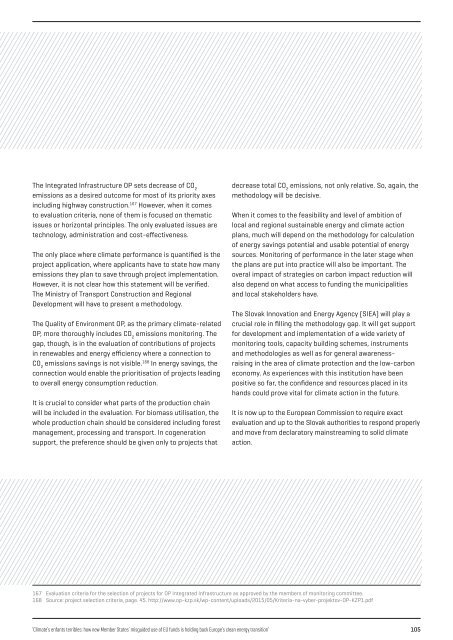ENFANTS TERRIBLES
enfants-terribles
enfants-terribles
Create successful ePaper yourself
Turn your PDF publications into a flip-book with our unique Google optimized e-Paper software.
The Integrated Infrastructure OP sets decrease of CO 2<br />
emissions as a desired outcome for most of its priority axes<br />
including highway construction. 167 However, when it comes<br />
to evaluation criteria, none of them is focused on thematic<br />
issues or horizontal principles. The only evaluated issues are<br />
technology, administration and cost-effectiveness.<br />
The only place where climate performance is quantified is the<br />
project application, where applicants have to state how many<br />
emissions they plan to save through project implementation.<br />
However, it is not clear how this statement will be verified.<br />
The Ministry of Transport Construction and Regional<br />
Development will have to present a methodology.<br />
The Quality of Environment OP, as the primary climate-related<br />
OP, more thoroughly includes CO 2<br />
emissions monitoring. The<br />
gap, though, is in the evaluation of contributions of projects<br />
in renewables and energy efficiency where a connection to<br />
CO 2<br />
emissions savings is not visible. 168 In energy savings, the<br />
connection would enable the prioritisation of projects leading<br />
to overall energy consumption reduction.<br />
It is crucial to consider what parts of the production chain<br />
will be included in the evaluation. For biomass utilisation, the<br />
whole production chain should be considered including forest<br />
management, processing and transport. In cogeneration<br />
support, the preference should be given only to projects that<br />
decrease total CO 2<br />
emissions, not only relative. So, again, the<br />
methodology will be decisive.<br />
When it comes to the feasibility and level of ambition of<br />
local and regional sustainable energy and climate action<br />
plans, much will depend on the methodology for calculation<br />
of energy savings potential and usable potential of energy<br />
sources. Monitoring of performance in the later stage when<br />
the plans are put into practice will also be important. The<br />
overal impact of strategies on carbon impact reduction will<br />
also depend on what access to funding the municipalities<br />
and local stakeholders have.<br />
The Slovak Innovation and Energy Agency (SIEA) will play a<br />
crucial role in filling the methodology gap. It will get support<br />
for development and implementation of a wide variety of<br />
monitoring tools, capacity building schemes, instruments<br />
and methodologies as well as for general awarenessraising<br />
in the area of climate protection and the low-carbon<br />
economy. As experiences with this institution have been<br />
positive so far, the confidence and resources placed in its<br />
hands could prove vital for climate action in the future.<br />
It is now up to the European Commission to require exact<br />
evaluation and up to the Slovak authorities to respond properly<br />
and move from declaratory mainstreaming to solid climate<br />
action.<br />
167<br />
168<br />
Evaluation criteria for the selection of projects for OP Integrated Infrastructure as approved by the members of monitoring committee.<br />
Source: project selection criteria, page. 45. http://www.op-kzp.sk/wp-content/uploads/2015/05/Kriteria-na-vyber-projektov-OP-KZP1.pdf<br />
‘Climate’s enfants terribles: how new Member States’ misguided use of EU funds is holding back Europe’s clean energy transition’ 105


